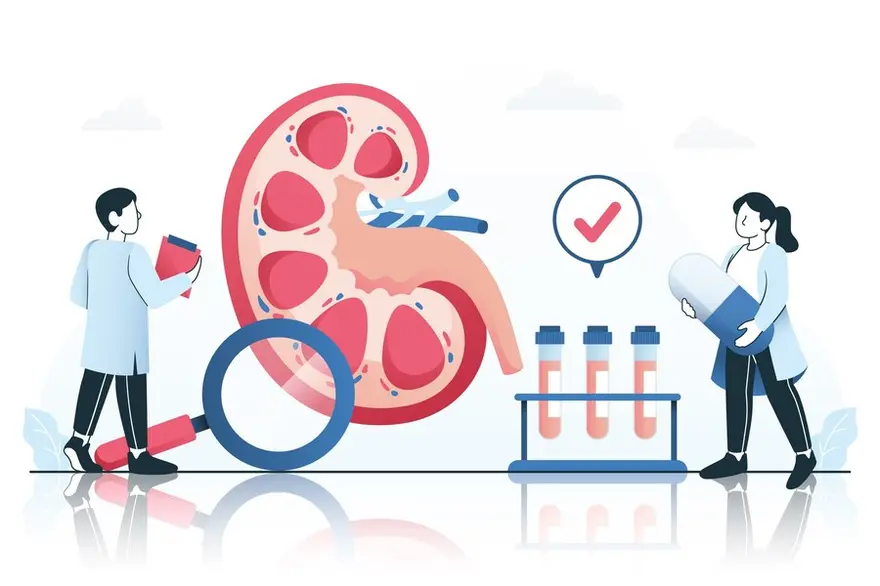Latest Blogs
Nystagmus: Causes, Symptoms, Types, and Treatment
What is Nystagmus? Nystagmus is a vision condition characterised by uncontrolled, rapid eye movements. These movements can happen in different patterns: side-to-side (horizontal), up-and-down (vertical), or in a circular motion (rotary). As a result, people with nystagmus may have vision-related challenges such as trouble seeing clearly, judging distances, and keeping their balance or coordinating movements. What Are the Types of Nystagmus? There are two main nystagmus types based on the age of onset: Congenital or Infantile Nystagmus: Babies with nystagmus usually start showing symptoms between 6 weeks and 3 months old. The exact cause is unclear, but it can be inherited from parents. Children with congenital nystagmus may often have it in both eyes, with the eyes typically moving side to side. The main symptom is blurry vision. Acquired Nystagmus: Acquired nystagmus develops later in life and is common in adults. It can be a symptom of a medical condition affecting the brain, eyes, or ears, but sometimes it isn’t linked to any specific condition. Acquired nystagmus can also result from an alcohol and drug use. Adults suffering from an acquired nystagmus often describe their symptoms as shaky vision. Spasmus Nutans: A specific type of acquired nystagmus called Spasmus Nutans affects children, usually diagnosed between 6 months and 3 years old. This type usually improves without treatment between ages 2 and 8. In addition to the age of onset, nystagmus can also be classified based on the type of eye movement: Jerk Nystagmus: Characterised by a slow drift in one direction followed by a fast corrective movement in the opposite direction Pendular Nystagmus: The eye movements are smooth and equal in both directions, resembling a pendulum Rotary or Torsional Nystagmus: The eyes move in a circular or rotational pattern Understanding nystagmus types and causes is important to determine the appropriate treatment and management strategies. How Common is Nystagmus? While the exact number of people with nystagmus isn’t fully known, it’s estimated that about 6 to 24 out of every 10,000 people may have some form of nystagmus. Is Nystagmus a Serious Condition? While nystagmus itself may not pose severe risks, it could signal other serious health conditions affecting the brain such as stroke, brain tumour, toxicity, and head trauma. What are the Symptoms of Nystagmus? One of the most noticeable nystagmus symptoms is uncontrollable eye movements. Some other signs may include a sensation of moving surroundings (oscillopsia), blurry vision, balance problems, light sensitivity, and dizziness or vertigo. What Causes Nystagmus? Nystagmus is characterised by involuntary eye movements and can be caused by various factors. Common nystagmus causes include congenital conditions, where individuals are born with the disorder, often presenting symptoms in infancy. Genetic factors may play a role, but the exact cause is often unclear. Acquired nystagmus develops later in life and can result from several underlying health issues. Neurological disorders, such as multiple sclerosis or stroke, are some of significant nystagmus causes, affecting the brain regions that control the eye movements. Additionally, inner ear problems, like Meniere's disease and vestibular disorders, can cause nystagmus because they affect balance and how we understand our position in space. Substance use is another factor; excessive alcohol intake and certain medications, such as anticonvulsants or sedatives, can also lead to nystagmus. Nutritional deficiencies, particularly thiamine or vitamin B12 deficiencies, may also contribute to the condition. Understanding these nystagmus causes is essential for effective diagnosis and treatment. How is Nystagmus Diagnosed? An ophthalmologist diagnoses nystagmus. They perform several tests, including a detailed examination of the eyes and vision testing. Other diagnostic methods may involve eye-movement recordings, ear examinations, neurological evaluations and imaging tests such as CT scans and MRIs. What are the Tests to Diagnose Nystagmus? Diagnosing nystagmus typically involves a comprehensive eye exam and specialised tests to determine the type and underlying cause. The most common tests include: Eye Movement Recordings: Devices such as an electronystagmography (ENG) or a videonystagmography (VNG) are used to record eye movements. This helps confirm the type of nystagmus and analyze its specific characteristics. Caloric Reflex Test: In this test, one ear canal is stimulated with warm or cold water or air. This activates the horizontal semicircular canal, which can provoke nystagmus. Optokinetic Testing: Rapid moving images are presented to observe how the eyes track them, as nystagmic eye movements are a natural reaction to the stimuli. Positional Testing: The patient's head is turned in different positions to check for positional nystagmus. This can help identify inner ear disorders, such as benign paroxysmal positional vertigo (BPPV). These tests, along with thorough medical history and physical examination, help diagnose nystagmus and identify any underlying neurological or vestibular conditions. Can Nystagmus Be Corrected? While people born with nystagmus cannot be completely cured, they can benefit from glasses or contact lenses that may help slow down eye movements. In some rare cases, surgery might be needed to reposition certain eye muscles. However, surgery doesn't cure nystagmus; it merely allows individuals to maintain their head in a more comfortable position. In some cases, acquired nystagmus can resolve if the underlying condition is treated. What Are the Treatments For Nystagmus? Nystagmus treatment strategies depend on the root cause. They may include: Glasses or Contact Lenses For individuals with nystagmus, wearing glasses or contact lenses can help improve vision. Special prism lenses may be prescribed to reduce the amount eye movement needed to see clearly. These optical aids can enhance visual acuity and minimising the impact of nystagmus on daily activities. Medications Several medications can be effective manage nystagmus symptoms. Muscle relaxants or medications such as anticonvulsants have shown promise in reducing certain nystagmus types and can also alleviate symptoms for some patients. The medication choice is based on the reason for the nystagmus and how well each person responds. Eye Muscle Surgery In cases where nystagmus significantly affects vision, eye muscle surgery may be an option. This surgery involves repositioning the eye muscles to improve alignment and reduce abnormal eye movements. While surgery doesn’t cure nystagmus, it can help enhance vision and reduce the need to tilt the head, making it easier for people to see clearly. Vision Correction Surgery Laser vision correction surgeries, such as LASIK, may benefit patients with nystagmus who are nearsighted. Although these procedures do not cure nystagmus, but they can improve overall vision clarity, potentially reducing the symptoms associated with the condition. How can I Prevent Nystagmus? Nystagmus can't always be prevented, especially if it's congenital. However, managing the underlying conditions that cause acquired nystagmus can help lessen its effects. What can I Expect if I Have Nystagmus? If you have nystagmus, you may experience involuntary eye movements that can cause blurred vision, dizziness, and depth perception issues. Symptoms can vary based on the type and cause. Treatment options include glasses, contact lenses, prism lenses, medications, and in some rare cases surgery to adjust eye muscles. With the right management, many people with nystagmus can reduce its effects on their daily life. When to see a Doctor? Getting a timely diagnosis and treatment is essential for managing nystagmus. If you experience any of the symptoms, it’s important to see a healthcare provider as soon as possible. Conclusion Understanding and managing nystagmus is important for those who have it. Remember, you’re not alone; medical professionals are there to support and guide you throughout every step of the way. For any pathology-related concerns or testing services, Metropolis Healthcare can be your trusted partner. Their advanced labs, at-home sample collection facilities, and reliable test results empower patients with accurate information, enabling them to make an informed decisions about their health. Whether it's understanding your health better or scheduling a home visit for testing, remember that it’s your health, and you have the power to prioritise it!
Bruises (Ecchymosis): Key Insights for Better Skin Health
Introduction Frequently noticed yet often misunderstood, bruises are common skin conditions that can trigger curiosity and concern. Known medically as ecchymosis, bruises are areas of discolouration that result from bleeding beneath the skin’s surface. This article seeks to demystify bruises and provide you with a clear understanding of these dermatological phenomena. In this article, we'll explore bruise causes and bruise types, identify their symptoms, discuss diagnosis and treatment methods, and outline effective preventive measures. By enhancing your knowledge, you can take steps towards managing and reducing the frequency of bruises effectively. What is a Bruise (Ecchymosis)? Bruises, or ecchymosis, are skin discolourations caused by the rupture of small blood vessels under the skin, leading to localised bleeding. These blood vessels break due to an impact or injury, resulting in reddish, purplish, greenish, bluish, or blackish patches on the skin, which may or may not be painful. Over time, bruises typically change colour as the body reabsorbs the blood. While most bruises are harmless and heal on their own, some can be a sign of an underlying medical condition or more serious injury, requiring medical attention. Who Gets Bruises? While anyone can acquire bruises, certain individuals are more susceptible due to various factors. These include: Older adults, as aging leads to thinner, more fragile skin and reduced elasticity. Women, who may bruise more easily due to hormonal differences. Children under 10, as their skin is more delicate and prone to injury. Individuals with thin or fragile skin, which is more vulnerable to damage. People on medications like blood thinners, aspirin, or steroids, which affect blood clotting. Those with low platelet counts or bleeding disorders, where even minor injuries can cause significant bruising. Additionally, nutritional deficiencies, such as low vitamin C or K, may increase bruising. Genetics can also play a role, as some people inherit traits that make them more prone to bruising. Regular exercise may strengthen muscles, providing protection against injuries that lead to bruises. What are the Symptoms of a Bruise (Ecchymosis)? Besides skin discolouration, other symptoms of a bruise include pain, tenderness, and swelling. The area may also feel warm to the touch. When a skin appears to be reddish, greenish, purplish, blackish, or bluish, it is considered a bruise. Bruise symptoms can vary from person to person. What Colour are Bruises? On lighter skin tones, bruises can appear reddish, purplish, greenish, bluish, or blackish. For darker skin tones, they may look dark purple, brown, or black. What are the Types of Bruises? The main types of bruises include: Petechiae: Tiny red dots less than 2mm wide Purpura: Larger reddish-purple patches 4mm to 1cm wide Ecchymosis: Larger bluish-purple or black bruises over 1cm wide What Causes Bruising (Ecchymosis)? Bruising, or ecchymosis, occurs when trauma or injury damages the small blood vessels under the skin, leading to localized bleeding and skin discoloration. Bruise causes can result in different levels of skin discoloration, depending on the severity of the underlying issue. Some bruise causes include: Trauma or injury: Physical impacts or accidents are the most common causes of bruising. Medications: Blood thinners, aspirin, and steroids can make bruising more likely by affecting blood clotting. Bleeding disorders: Conditions like hemophilia or low platelet counts hinder the body’s ability to clot properly, increasing the risk of bruising. Vitamin deficiencies: Lack of vitamin C or K can weaken blood vessels, leading to easier bruising and increased fragility. Aging skin: Older adults are more prone to bruising due to thinning skin and reduced elasticity. Medical conditions: Diseases affecting platelets or blood clotting can increase bruising risk, making it essential to monitor any unusual bruising patterns. How are Bruises (Ecchymosis) Diagnosed? Doctors diagnose bruises (ecchymosis) by examining the skin and asking about recent injuries, medications, and medical history. They may also inquire about the frequency of bruises. If a bleeding disorder is suspected, they might order blood tests to check clotting ability. Based on the results, your doctor can identify the causes of bruising, recommend treatments, and offer helpful tips on preventing future bruises and effectively managing any underlying health conditions that may contribute to frequent bruising. How are Bruises (Ecchymosis) Treated? Most minor bruises (ecchymosis) can be treated at home using the RICE method (Rest, Ice, Compression, Elevation) to reduce swelling and promote healing. Over-the-counter pain relievers like ibuprofen can help alleviate discomfort. However, if bruising is severe, persistent, or unexplained, it’s important to seek medical attention for proper bruise treatment. Your doctor may investigate underlying causes and offer personalised bruise treatment options, especially if the bruising is related to a medical condition like a bleeding disorder. Consult your doctor to ensure the best care, prevent complications, and promote effective healing while reducing the risk of future occurrences and safeguarding your overall well-being for optimal health. How Can I Prevent Bruises (Ecchymosis)? While bruises cannot be completely prevented, taking some proactive measures can help reduce the risk of developing them. Some helpful steps include: Avoiding skin trauma by being mindful of your surroundings Using protective gear during sports or high-risk activities to prevent injuries Being cautious with medications that may increase bruising risk, such as blood thinners Strengthening your body with a balanced diet rich in vitamins C and K, which help support healthy skin and blood vessels Protecting ageing skin by moisturising and avoiding harsh impacts What Can I Expect If I Have a Bruise (Ecchymosis)? Most minor bruises heal by themselves within two weeks. The colour of the bruised area may change as it heals. It's crucial to seek medical attention if the bruising is bruising severe, unexplained, or accompanied by other symptoms. Your doctor is the best person to advise your bruise. How Long Do Bruises Last? The healing duration for bruises varies from a few days to several weeks, depending on severity. A moderate bruise typically fades fully in about two weeks, while bruises on the lower legs may take longer to heal. Remember, as every individual is different, so is the healing journey for all. When to See a doctor? You should consult a doctor if you notice sudden, unexplained bruising, severe bruising, or if the bruising doesn't fade within two weeks. Seek immediate medical care if you experience symptoms like fever, shock, or uncontrolled bleeding alongside bruising. Conclusion Bruises (ecchymosis) are a common type of bleeding under the skin caused by broken blood vessels. While most minor bruises heal on their own, severe or unexplained cases require prompt medical attention. Prevention plays a key role in managing bruises; this includes avoiding trauma to the skin and taking precautions related to ageing skin and certain medications. By understanding the bruises causes, types, symptoms, and bruises treatment options for bruises, you can take control of your dermatological health and better manage these common conditions. In case you've noticed recurring instances of bruising or unexplainable ones that seem concerning, reach out to Metropolis Healthcare for reliable pathology testing services. Metropolis offers at-home sample collection services, processed at our advanced diagnostic labs, with the results shared online for your convenience. Prioritise your health with accurate and personalised care by choosing Metropolis Labs.
Vaginismus: Types, Causes, Symptoms, and Treatment
Introduction Have you ever felt a sudden tightening or contraction in your vagina during sexual activity or when inserting a tampon? If yes, you might be facing a condition known as vaginismus. This involuntary tensing of the vaginal muscles can cause discomfort and pain during sex, tampon use, or pelvic exams. But, what exactly is vaginismus? How common is it? And, most importantly, what are the effective treatment options available? In this comprehensive guide on vaginismus, vaginismus treatment, vaginismus symptoms and vaginismus causes, we aim to answer these questions and more. We will also discuss various types of vaginismus and share helpful self-care exercises to help you in managing this condition. What is Vaginismus? Vaginismus is a medical condition where the vaginal muscles tighten whenever something tries to penetrate it, like a tampon or during sexual intercourse. This might range from a mild discomfort to an intense pain. This condition can be divided in two types: primary and secondary vaginismus. It involves involuntary muscle spasming around the vagina when penetration is attempted, by a penis, finger, tampon or even a medical instrument during an examination. Primary Vaginismus Also known as lifelong vaginismus, this type occurs when a woman experiences pain whenever there is an attempt to penetrate the vagina or if she has never been able to insert anything into her vagina. Secondary Vaginismus Secondary or acquired vaginismus occurs when a woman who had previously experienced painless penetrative sex suddenly finds it difficult or impossible due to discomfort or pain. How Common Is Vaginismus? It's hard to determine the exact prevalence of vaginismus as many individuals may feel uncomfortable discussing it with their healthcare providers. Therefore, the condition may remain underreported globally. The condition remains under-researched due to existing stigmas around female sexuality and health. However, studies have also suggested that it affects roughly 1% to 7% of females worldwide. The prevalence might actually be higher, given that many women may hesitate to report their difficulties due to societal norms or their own embarrassment. Who Might Get Vaginismus? Any woman can experience vaginismus symptoms during her late teen years or an early adulthood when engaging in sexual activities for the first time. However, some women may develop vaginismus later in life, even after years of having pain-free sex. Spasms or discomfort can happen at any point during vaginal penetration. Vaginismus can affect women of all ages and is often associated with anxiety or fear related to sex. Women who have had infections, those undergoing menopause, or having certain medical conditions might also experience it. What Causes Vaginismus? The exact cause of vaginismus remains unknown, but several factors are thought to contribute to its development, including: Anxiety disorders Injuries from childbirth, such as vaginal tears Previous surgeries on or near the vagina Fear or negative emotions related to sex stemming from past sexual abuse or trauma Interestingly, the exact causes of vaginismus are still unknown. It's usually linked with fear or anxiety around sex, it's not always clear which comes first: the vaginismus or anxiety. Some women may experience vaginismus in every situation and with any object, while others may only encounter it in certain circumstances. What Conditions Are Similar to Vaginismus? Symptoms similar to those of vaginismus can also be caused by conditions such as: Vaginal Atrophy: This occurs due to decreased estrogen levels after menopause, leading to a thinner and drier vaginal lining. Vulvar Vestibulitis (Provoked Vestibulodynia): This condition results in painful intercourse (dyspareunia), with pain varying from initial penetration throughout the entire experience. Dyspareunia (pain during sexual intercourse) and genito-pelvic pain/penetration disorder (GPPPD) are two conditions similar to vaginismus. However, it is essential to clarify that each condition has its unique features and requires a specific diagnosis and treatment plan. What Are the Symptoms Of Vaginismus? Some common symptoms include: Dyspareunia (painful intercourse) Difficulty inserting anything into the vagina Long-term sexual pain Pain during tampon insertion Discomfort during gynaecological examination These symptoms vary from person to person and range from mild discomfort to severe pain during attempts at vaginal penetration. If you have painful sex or discomfort while inserting a tampon, it's essential to consult a doctor as these feelings aren't normal. How Is Vaginismus Diagnosed? For diagnosing vaginismus healthcare provider will review your medical and sexual history and conduct a pelvic exam to rule out other potential causes of your symptoms. A topical numbing cream may be applied to make the process more comfortable. Your healthcare provider will also discuss symptoms and medical history as part of the diagnosis, and the pelvic exam may also be conducted to rule out other health conditions that could cause pain. How is Vaginismus Treated? Vaginismus treatment usually involves exercises at home to learn how to control and relax the muscles around the vagina. This approach is known as a progressive desensitisation. Kegel exercises are often advised, and for some women undergoing a therapy may also provide support, particularly if vaginismus is linked to fear or anxiety. Luckily, various treatment methods address both physical and psychological aspects of vaginismus. Your healthcare provider may recommend one or more of the following treatments: Topical Therapy: Topical lidocaine or specially compounded creams may alleviate pain associated with vaginismus. Pelvic Floor Physical Therapy: A physical therapist will guide you in learning how to relax your pelvic floor muscles. Vaginal Dilator Therapy: Vaginal dilators are used to gently stretch the vagina and help it adjust to penetration. Cognitive Behavioural Therapy (CBT): CBT focuses on understanding how your thoughts impact your emotions and behaviours, making it effective for addressing anxiety, depression, and PTSD. Sex Therapy: Trained sex therapists assist individuals and couples in rediscovering pleasure in their sexual relationships. What Are the Complications of Vaginismus? Without treatment, vaginismus can cause emotional distress, relationship problems, and problems with self-esteem issues. However, with an effective treatment and support from healthcare providers, these complications can be mitigated. Vaginismus can impact your sexual life, causing stress in relationships, and affect your mental health if not addressed. It can also make it harder to conceive if you're trying to get pregnant. How Can I Prevent Vaginismus? Preventing vaginismus mainly involves managing risk factors such as anxiety or stress related to sex and addressing any underlying medical conditions that may cause pain during penetration. Additionally, regular pelvic floor exercises can help maintain healthy muscle tone. What is Outlook for People with Vaginismus? With the right treatment plan and support, women with vaginismus can regain control over their bodies and enjoy a healthy sex life. Therapy often plays a crucial role in this process. When to See a doctor? If you experience recurring pain during sex or find it impossible to have penetrative sex due to discomfort or pain, it's advisable to consult a healthcare provider. Early diagnosis can lead to more effective treatment. Conclusion Vaginismus which can be challenging and uncomfortable, is treatable with a proper care. Understanding your body better helps you make informed health choices. Metropolis Healthcare offers an extensive diagnostic services providing valuable insights into your health. Their team of skilled technicians ensures a safe at-home blood sample collection service for analysis at advanced diagnostic labs. Additionally, Metropolis Healthcare is committed to deliver reliable results, helping you prioritise your health. Don’t let vaginismus go untreated; reach out for professional guidance today.
Penile Cancer: Symptoms, Causes, and Treatment Options
Introduction Health is our most precious asset. However, many of us don't pay attention to it until we face a health concern. One of such concern that often goes unnoticed until it’s too late is penile cancer. Although it is relatively rare as compared to other forms of cancers, penile cancer represents a serious type of concern impacting men's health. This article provides a comprehensive overview of penile cancer, covering its types, symptoms, causes, treatment options, and management strategies. Our main aim is to empower you with the necessary knowledge required to make informed choices about your health. Penile cancer is an uncommon form of cancer that typically affects older adults, though it can develop in individuals of any age. It involves the growth of malignant cells within the penis, causing alterations in its normal structure and function. While the term "cancer" can be alarming, gaining an understanding the nature of the disease, its symptoms, its causes, and available treatment options can help alleviate some of the associated anxiety. In this article, we delve into penile cancer types, how common it is and at what penile cancer age it usually occurs. What is Penile Cancer? Penile cancer is a condition characterised by the formation of malignant (cancerous) cells form in the tissues of the penis. The penis functions as a male reproductive organ, facilitating sexual intercourse and urination. It is mainly made up of two sections: the shaft (the longer part), and and the glans or head (the tip). In uncircumcised males, a layer of skin known as foreskin covers the head of the penis. While penile cancer can develop in any area of the penis, it frequently affects the glans or foreskin. What are the Types of Penile Cancer? Penile cancer is a rare condition, but it can appear in various forms, each with its own traits and treatment methods. Understanding these types is key for recognizing and detecting the disease early. Below are the main types of penile cancer: Squamous Cell Carcinoma (SCC): This type accounts for approximately 95% of all penile cancer cases. It originates in the epithelium, which is the top layer of skin covering the penis. Basal Cell Carcinoma (BCC): A slow-growing form of penile cancer, BCC begins in the lower layer of the epithelium and is less aggressive than SCC. Melanoma: This aggressive form of penile cancer starts in melanocytes, which are the cells that produce skin color. Sarcoma: Very rare, sarcoma occurs in the muscle or connective tissues around the penis. How Common is Penile Cancer? Penile cancer accounts for less than 1% of cancers among men in countries like the U.S., but in some areas of Africa, Asia, and South America, it is much more prevalent, accounting for more than 10% of cancers in males. At What Age Does Penile Cancer Usually Occur? The average age for a penile cancer diagnosis is 60, with most diagnoses occurring in individuals over 55. However, it can also affect men below 40 years old. What are the Symptoms of Penile Cancer? Penile cancer often manifests visible changes in the penis, highlighting the importance for men to be aware of these signs. Detecting changes early can improve outcomes, so acknowledging any of these unusual developments is important. These changes may include: A painless lump or sore on the penis that can bleed Skin thickening or changes in skin color Foul-smelling discharge beneath the foreskin Small, crusty bumps on the penis Unusual growths that look blueish-brown If you experience any symptoms of penile cancer, it’s important to consult a healthcare provider, as they could be early warning signs. What Causes Penile Cancer? The exact cause of penile cancer remains unknown, but it begins when a healthy cell transforms into a cancer cell and starts to multiply uncontrollably. Over time, these cancer cells can push out healthy cells and spread to other parts of the body. Penile cancer occurs when the normal cells in your skin transform into cancerous cells. As these cells multiply, they form a mass called tumor, which invade surrounding healthy tissue and spread. As researchers explore the causes of this change, they have identified several risk factors. What are the Risk Factors for Penile Cancer? The main risk factors for penile cancer include being older (around 80% of cases occur in individuals over 55 years), an uncircumcised status (which increases risks related to having a foreskin), phimosis (inability to retract the foreskin), HPV infection, HIV infection, tobacco use, PUVA treatment for psoriasis, lichen sclerosis (an inflammatory condition), and inadequate hygiene. Is Penile Cancer Contagious? Penile cancer is not contagious. However, Human Papillomavirus (HPV), a significant risk factor for penile cancer, can be transmitted through sexual contact. How is Penile Cancer Diagnosed? To diagnose penile cancer, your healthcare provider will conduct a physical exam and history-taking by your healthcare provider. If they find any suspicious cells or tissues, they may perform a biopsy to confirm the diagnosis. Imaging tests such as CT scans, MRIs, ultrasounds, PET scans, or chest X-rays may also be ordered to determine the extent of spread. What are the Stages of Penile Cancer? Penile cancer stages are classified using the TNM system, which consists of three components: T (Tumor): This indicates the size of the tumor and how deeply it has invaded the penis. N (Lymph Nodes): This shows whether the cancer has spread to nearby lymph nodes. M (Metastasis): This indicates whether the cancer has spread to distant organs. The numbers following TNM provide more specific details about the size, extent, and involvement of lymph nodes, helping to determine the overall stage of the cancer. How is Penile Cancer Treated? Treatment options depends on factors such as the tumor's size, the extent of cancer spread, and the chances of recurrence. For early-stage cancer, treatment approaches may include medicated creams, circumcision, laser ablation, cryotherapy, Mohs surgery, excision, and radiation therapy. For advanced stages, treatments may include penectomy (removal of part or all of the penis) or lymphadenectomy (removal of affected lymph nodes). How Can I Reduce My Risk of Penile Cancer? Preventive measures include infant circumcision, prompt treatment for phimosis, receiving the HPV vaccine (particularly for those aged 9 to 26), practicing safer sex, avoiding tobacco products, and a maintaining proper hygiene. What Can I Expect If I Have Penile Cancer? Your prognosis depends on the cancer's stage, the tumor's location and size, and whether it’s newly diagnosed or recurring. An early detection typically allows for easier treatment and a higher chance of cure. In contrast, later-stage diagnosis may indicate that the cancer has spread, making treatment more challenging. Regular check-ups can aid in early detection. Is Penile Cancer Fatal? Penile cancer can be fatal if it spreads beyond the penis. However, adopting preventive habits like practicing safer sex and avoiding tobacco can help reduce your risk. How do I Take Care of Myself? Maintaining open communication with your healthcare provider is crucial for managing life after a penile cancer diagnosis. It's important to talk about how your treatment plan might affect your daily activities and to establish a support system that can assist you throughout this journey. Consult your healthcare provider about how your cancer and treatment plan might affect your daily life. Many cancer treatments preserve penile tissue, so your penis is likely to heal to look much the same as it did before. You should still be able to urinate while standing, achieve erections, have sex, and experience orgasms. Surgically removing part or all of your penis may change the way you urinate and your experience of sex. Penile cancer treatment can unfold in various ways. Understanding what to expect can help you prepare for different possible scenarios. It's important to communicate openly with your healthcare provider about any questions or concerns you may have. Conclusion Understanding the symptoms and causes of penile cancer, knowing its types, and treatment options empowers you to take control of your health. Regular checks and screenings play a vital role in early diagnosis and intervention, enhancing survival rates. Metropolis Healthcare offers a wide network of advanced diagnostic labs across India, ensuring accurate testing services from the comfort of your doorstep. An expert team of technicians collects samples from your home, ensuring convenience without compromising accuracy or safety. Stay informed and vigilant; taking care of your health is within reach with knowledge and professional medical care. An expert team of technicians collect samples at home, ensuring convenience without compromising accuracy or safety. Stay informed, stay vigilant, and remember: taking care of your health is within reach with knowledge and professional medical care.
Abscess: Symptoms, Causes, Treatment and Types
Have you ever noticed a painful, red swelling on your body that feels warm to the touch? You may be dealing with an abscess, a common health issue that can cause significant discomfort if not treated promptly. But what is an abscess? And why should you be aware of its causes and treatment methods? Read this article to know more about what an abscess is, what are its different types, symptoms, and treatment options. What is an Abscess? An abscess is a painful, swollen area filled with pus, usually resulting from a bacterial infection. The body's immune system responds to the infection by sending white blood cells to the affected area, where they accumulate along with dead tissue, forming pus. This collection of pus causes the swelling and inflammation characteristic of an abscess. Abscesses can occur anywhere in the body, including the skin, teeth, or internal organs, and may cause additional symptoms such as redness, warmth, and tenderness. What are the Different Types of Abscesses? There are different types of this painful condition which involve collection of pus such as skin abscess, abscesses in your mouth, internal abscess, etc. Let us look at each of them in detail. Skin Abscesses Skin abscesses are the most common type of abscess and can occur anywhere on the body. They are most often found on the face, back, lower abdomen, buttocks, or in areas with dense hair growth, such as the underarms and groin. Examples of skin abscesses include boils, furuncles, and carbuncles. Abscesses in Your Mouth Abscesses developed inside your mouth around your gums or teeth or even in your throat these are known as mouth abscesses. These are generally associated with gum disease or cavities and can be very painful. Internal Abscesses Finally, we have internal abscesses, which form within our organs or in the spaces between them. These are the most difficult to diagnose and treat. What Does an Abscess Look Like? An abscess on your skin appears as a painful, red, swollen bump. It may feel soft or "squishy," with the surrounding skin inflamed and warm to the touch. How Does an Abscess Form? Abscesses usually form when bacteria invade your body through a break in your skin or mucous membranes. Your immune system responds by attacking the infection, leading to inflammation, tissue death, and the formation of pus creating an abscess. How is an Abscess Diagnosed? The diagnosis of an abscess depends on its location and severity. For skin abscesses, a physical examination is usually sufficient for healthcare providers to identify the swollen, tender area filled with pus. Your doctor may ask about the injury or infection history that led to the abscess, as well as any symptoms like pain or fever. Mouth abscesses, such as dental abscesses, can also be diagnosed through a physical exam and, in some cases, dental X-rays. However, diagnosing internal abscesses requires advanced imaging techniques, as they are not visible externally. In these cases, your doctor may order ultrasounds, CT scans, or MRIs to locate the abscess and assess its size and impact on surrounding organs or tissues. Blood tests may also be performed to identify infection markers. It’s essential to consult a healthcare professional for a proper diagnosis of the abscess, its underlying causes, and the best treatment options to avoid serious complications in the future. How is an Abscess Treated? The approach to treatment of abscesses largely depends on their size, location, and severity. Small skin abscesses might drain on their own or improve with home treatments like warm compresses, which help release pus and decrease swelling. In contrast, larger or more serious abscesses usually need medical attention. A healthcare provider may need to perform a minor procedure with a scalpel or needle to drain the pus. This form of abscess treatment is often accompanied by a course of antibiotics to prevent or treat infections, especially in cases of large, deep, or recurrent abscesses. For internal abscesses, the treatment is more complex and often involves a surgical drainage, which may be guided by imaging tests like ultrasounds or CT scans. Antibiotics are generally prescribed to combat any underlying infection. After drainage, proper wound care is crucial to promote healing and prevent further complications. Patients are usually advised to keep the area clean and to monitor for any signs of worsening infection, such as increased pain, redness, or fever. In addition to these treatments, follow-up appointments may be necessary to ensure the abscess is healing correctly. Education about signs of infection and proper care techniques is essential for optimal recovery. Always consult your healthcare professional for a personalised abscess treatment plan that best suits your condition, as individual healing processes can vary depending on overall health and the severity of the abscess. Effective management is key to ensuring a swift recovery and preventing recurrence. Timely intervention can significantly improve outcomes and quality of life. How Can I Prevent an Abscess? While it is not completely possible to prevent abscesses, there are some steps you can take to reduce the chances of an abscess occurring. You can reduce the chances of skin abscesses by maintaining good personal hygiene, washing your hands regularly, avoiding shared personal items like towels and razors, and promptly treating minor skin infections. To avoid dental abscesses, ensure you practice good oral hygiene and get regular dental check-ups. What is the Outlook for an Abscess? Usually, abscesses heal well with appropriate treatment. However, if left untreated, they can spread infection to other parts of the body. In rare cases, internal abscesses can be life-threatening if they burst or cause organ damage. The outlook for an abscess might vary from person to person. How Do I Take Care of Myself After Treatment for an Abscess? Post-treatment, make sure to keep the area clean and change dressings as directed. If antibiotics are prescribed, take them according to your doctor's instructions. When to See a doctor? You should seek medical assistance if you suspect an abscess, particularly if it is large, painful, or accompanied by a fever. Immediate medical attention is necessary for abscesses near your eyes, on your face, in your genital area, or internally. What's the Difference Between an Abscess and a Boil? A boil is a type of skin abscess associated with a hair follicle. They're typically smaller than other skin abscesses and can occur in clusters known as carbuncles. Conclusion Abscesses are common infections that can occur on the skin, in the mouth, or internally. While they are usually not serious, untreated abscesses can lead to complications. Therefore, early diagnosis and prompt abscess treatment are crucial. Metropolis Labs offers reliable diagnostic tests to help detect bacterial infections that may cause abscesses. Our qualified team of technicians provides at-home sample collection services for your convenience. Test results are shared online through our user-friendly TruHealth app. We are committed to delivering accurate results and personalised care to empower you in managing your health better. Remember, prioritising your health is within reach with the right knowledge.
Symphysis Pubis Dysfunction: Symptoms, Causes, and Relief Tips
What is Symphysis Pubis Dysfunction? Symphysis pubis dysfunction (SPD) causes discomfort in the pelvic area. The pelvic bones connect at the symphysis pubis joint, which is usually stable because of strong ligaments. If these ligaments become too relaxed, it can lead to joint instability and cause SPD. This condition can be quite painful and affect a person’s quality of life, but there are medical treatments and home remedies that can help provide relief. Who does it affect? Primarily, symphysis pubis dysfunction affects pregnant women. Fluctuations in hormone levels during pregnancy can soften the ligaments in the pelvic area to facilitate childbirth. However, this process can sometimes lead to SPD. Weight fluctuations during pregnancy can also add pressure to the pelvis and cause discomfort. It's important to note that not all pregnant women will experience SPD. In rare cases, SPD can be linked to arthritis or pelvic injuries. While it’s more common in women, men can also have SPD, though it’s less frequent. How common is Symphysis Pubis Dysfunction? Symphysis pubis dysfunction is surprisingly common during pregnancy. A study in The Journal of the Canadian Chiropractic Association reveals that about 31.7% of pregnant women experience SPD. What causes Symphysis Pubis Dysfunction? Symphysis pubis dysfunction (SPD) can result from several factors: Pregnancy: The hormone relaxing loosens pelvic ligaments, which can lead to instability. Trauma: Injuries from accidents can trigger SPD. Repetitive Force: Activities like horse riding may contribute to the condition. Other Conditions: Risk factors include obesity, calcium deficiency, weak abdominal muscles, anatomical variations, and infections. Joint Diseases: Osteoarthritis can cause cartilage breakdown, leading to SPD. Metabolic Diseases: Disorders like renal osteodystrophy can alter joint structure. SPD typically causes pain in the groin and inner thigh, with symptoms worsening when putting full weight on one leg. What are the symptoms of Symphysis Pubis Dysfunction? The intensity of symphysis pubis dysfunction symptoms varies greatly from person to person, with some may experience a mild discomfort, while others feel more intense pain The primary symptom is pelvic area, often described as shooting, aching, or grinding. This discomfort can extend to surrounding areas, including the upper thighs, lower back, hips, or perineum, making daily activities increasingly challenging. Other symphysis pubis dysfunction symptoms include: A clicking or popping sound in the pelvis Difficulty in walking or standing for extended periods Pain that worsens with weight-bearing activities, like climbing stairs, getting in and out of bed, or lifting objects Trouble with balance or coordination In rare cases, difficulty urinating or incontinence, particularly as pelvic pressure increases during pregnancy These symptoms can significantly impact overall quality of life and daily well-being. How is Symphysis Pubis Dysfunction diagnosed? Diagnosing symphysis pubis dysfunction (SPD) typically involves a thorough review of the person's symptoms, including a physical examination, and an assessment of their medical history. The doctor will ask about the nature and location of the pain, activities that worsen it, and any difficulties with movement or daily tasks. For pregnant women, symphysis pubis dysfunction diagnosis relies mainly on symptom assessment and physical examination, X-rays are generally avoided. In non-pregnant individuals, imaging tests like X-rays, CT scans, or MRI scans may be used to confirm the diagnosis and assess the extent of joint separation or inflammation. Early diagnosis is crucial for effectively managing symphysis pubis dysfunction symptoms and preventing further discomfort. How is Symphysis Pubis Dysfunction treated? Symphysis pubis dysfunction treatment depends on the severity of the condition and may involve medical interventions or home remedies which can help in alleviate pain and improve mobility. Possible symphysis pubis dysfunction treatment options include: Soft Tissue Therapy: This includes chiropractic care, spinal manipulation, and targeted massage to improve pelvic joint stability, alleviate pain, and reduce inflammation. These therapies can enhance blood flow and promote healing. Pregnancy Support Belt: Wearing a support belt in pregnancy helps stabilise the pelvic bones, improves posture, and maintains proper alignment, providing effective short-term relief from SPD symptoms during pregnancy. Stretches and Exercises: A doctor or physical therapist may suggest safe stretches and exercises to help improve mobility. These may include pelvic tilts, gentle yoga, and Kegel exercises. These activities can strengthen the pelvic floor muscles, reduce pain, and make movement easier. Home remedies are also effective for managing symphysis pubis dysfunction. Also including some simple practices like placing a pillow between your legs when sleeping, avoiding prolonged sitting or standing, using an ice pack on the pelvic area to reduce an inflammation, staying moderately active, and avoiding activities that worsen the pain can offer significant relief. Additionally, warm baths, gentle heat therapy, and frequent rest periods can help alleviate discomfort and promote healing. Staying mindful about your body’s signals is essential for recovery. How to prevent Symphysis Pubis Dysfunction? You can’t completely prevent pelvic joint pain during pregnancy, but you can protect your pelvic area from injury. Here are some simple tips to lower your risk of symphysis pubis dysfunction (SPD): Wear Supportive Shoes: Choose comfortable shoes that provide good support and avoid flip-flops. Maintain a Healthy Weight: Keep a healthy weight during your pregnancy; ask your doctor if you’re unsure what’s best for you. Listen to Your Body: If something hurts, stop doing it. Don’t push yourself too hard. Watch Your Posture: Be mindful of how you sit and move, and avoid twisting motions or activities that strain your pelvis, like squats. What can I expect if I have Symphysis Pubis Dysfunction? While symphysis pubis dysfunction can cause significant discomfort and impact daily life, it does not pose a direct risk to the baby. Symptoms usually subside after childbirth, but in severe cases, chronic pain may lead to mental health issues such as depression, which may require psychological support along with physical treatment. Can Symphysis Pubis Dysfunction lead to pregnancy complications? In most instances, symphysis pubis dysfunction does not cause pregnancy complications. Women with SPD can generally have vaginal deliveries. However, if the pain is severe and affects mobility, some women might have challenges during vaginal delivery. What is the difference between Symphysis Pubis Dysfunction and Pubic Symphysis Diastasis? While both conditions involve the pubic symphysis joint and can cause similar symptoms, symphysis pubis dysfunction (SPD) and pubic symphysis diastasis are different. Symphysis pubis dysfunction is characterised by excessive movement or flexibility in the pelvic joint causing instability and pain. In contrast, pubic symphysis diastasis involves an abnormal separation or widening of the joint, often due to trauma or childbirth complications. Conclusion Symphysis pubis dysfunction can be challenging to deal with, especially for pregnant women. However, learning about its symptoms, causes, and treatment options can help you manage it more effectively. It's important to seek guidance from your healthcare provider for personalised advice and support. For reliable diagnostic support, you may consider Metropolis Healthcare, a leading chain of diagnostic labs across India. Offering accurate pathology testing and health check-ups, with skilled technicians who can collect blood samples from the comfort of your home. The results are shared online via email or through the easy-to-use Metropolis TruHealth app, helping you stay informed about your health. Remember, knowledge empowers you, and professional healthcare guidance brings peace of mind on your path to well-being.
Nuchal Translucency: What It Is and Why It Matters
What Is Nuchal Translucency? The term ‘nuchal translucency’ refers to the fluid-filled area within the foetal tissue which is present at the back of your baby's neck. An ultrasound in the first trimester checks this fluid to see if there is a risk for certain genetic issues. Remember that an NT scan is just a screening. It can suggest if more tests are needed but does not confirm any conditions. What Does the Nuchal Translucency Test For? The nuchal translucency scan is a prenatal screening procedure performed during the first trimester of pregnancy, typically between 11 and 13 weeks. It measures the fluid-filled space at the back of the foetus's neck, known as nuchal translucency. A high NT scan measurement may suggest the presence of Down syndrome (Trisomy 21), Patau syndrome (Trisomy 13), Edwards syndrome (Trisomy 18), or congenital heart issue. Along with a maternal blood test that checks specific pregnancy hormones, the nuchal translucency measurement helps assess the risk for certain genetic conditions. A thicker nuchal translucency measurement may indicate a higher risk of abnormalities, while a normal measurement indicates a lower risk. It's important to remember that the NT scan is a screening tool and not a definitive diagnosis. If the results show a higher risk, further tests like amniocentesis or chorionic villus sampling (CVS) may be suggested to confirm or rule out any conditions. When Is a Nuchal Translucency Scan Done? An NT scan is typically done between the 11th and 13th weeks of pregnancy when the foetus measures between 45 and 84 millimeters from the crown (top of the head) to the rump (bottom of the torso). Beyond the 14th week, the fluid at the back of the baby's neck naturally gets absorbed, making it difficult to measure. What Is a First-trimester Screening Test? A first-trimester screening test, often called combined sequential screening, helps evaluate the risk of congenital conditions. It combines blood tests with an NT scan, offering more accurate results than the NT scan alone. Who Should Get a Nuchal Translucency Screening? A nuchal translucency screening is optional for all pregnant individuals. However, individuals over 35 or with a family history of genetic conditions may be advised to consider this screening. Healthcare providers recommend this scan for those who are between their 11th and 13th weeks of pregnancy. How Is Nuchal Translucency Screening Done? A nuchal translucency scan involves using a handheld ultrasound device. The probe can be positioned either on your abdomen or inside your vagina, depending upon factors like: Gestational age Baby's position Mother's body shape During the NT scan, the sonographer applies some gel to your abdomen and moves the ultrasound wand over it. The scan usually doesn’t cause any discomfort. If a transvaginal probe is needed, you will receive clear instructions beforehand. How Are the Results of A Nuchal Translucency Test Calculated? The results of a nuchal translucency procedure is calculated by measuring the thickness of the fluid-filled space at the back of the foetus's neck, and is usually performed between 11 and 13 weeks of pregnancy. The measurement is further compared to an established nuchal scan normal range value, which generally indicates a normal NT measurement is under 3.0 millimeters. If the NT measurement falls within this nuchal translucency normal range, it suggests a lower risk for chromosomal abnormalities, such as Down syndrome. Conversely, a thicker measurement may indicate a higher risk, prompting further evaluation. To improve the accuracy, the NT measurement is often combined with maternal blood tests that check hormone levels, such as free beta-human chorionic gonadotropin and pregnancy-associated plasma protein-A. This combined approach provides a more comprehensive risk assessment for genetic conditions. The results are presented as probabilities, indicating the likelihood of abnormalities. For example, 1 in 1000 means low risk, while 1 in 150 means higher risk, which may lead to further testing. The nuchal scan normal range can vary slightly on the gestational age, usually between 1.8 and 2.35 mm for the 95th percentile. Using these population-specific reference ranges can optimise screening results by reducing false positive cases. How Accurate Is the Nuchal Translucency Test? The nuchal translucency procedure is not an outright diagnostic tool, but it’s a risk assessment measure. When performed between 11 and 13 weeks of gestation, the NT scan alone can detect approximately 75-80% of Down syndrome cases in foetuses of mothers aged 35 and older. However, when combined with a blood test as part of a first-trimester screening, this accuracy increases to about 85%. This combined test looks at maternal age, hormone levels in the mother's blood, and the nuchal translucency measurement to provide a better overall risk assessment. Being aware of these numbers can help you understand the nuchal scan normal range and interpret your results with more precision and less anxiety. Are There Any Risks to The Screening? The great news about a nuchal translucency scan is that it poses no direct harm to either the mother or the baby. The procedure involves a standard, non-invasive, and painless ultrasound that doesn’t involve any radiation exposure or needles, ensuring complete safety with no risk of miscarriage. However, what could potentially be stressful for parents-to-be are the results, specifically those indicating high-risk. It’s important to remember that an abnormal result doesn’t confirm a genetic disorder but it simply indicates an increased risk for one. What Does an Abnormal Nuchal Translucency Test Mean? A thicker nuchal area identified during a NT scan directly correlates with higher chances of chromosomal abnormalities in the foetus. Essentially, if your result falls outside nuchal scan normal range, it denotes 'high risk'. However, before panic sets in, it's important to remember that 'high risk' isn't a diagnosis. For example, among 100 women with a high-risk result, only about 5 would have babies with a chromosomal disorder. An abnormal test result can simply indicate the need for further diagnostic tests, such as Chorionic Villus Sampling (CVS) or Amniocentesis. Additionally, factors like maternal age and family history can influence how results are interpreted. It’s important to consult with a healthcare professional to understand a implications of an abnormal NT scan and to discuss potential follow-up testing options. Early detection helps with planning and managing any risks, making sure that both the mother and baby get the right care and support during the pregnancy. What Is the Normal Nuchal Translucency Measurement? Knowing what’s normal can help you understand your nuchal translucency scan results. The thickness of the nuchal fluid is usually considered normal if it measures less than 3.5 millimeters during weeks 11 to 13 of pregnancy. It's important to note that as the foetus grows week by week, and so does the nuchal translucency. Hence, your healthcare provider will consider both the NT measurement and gestational age to determine if it lies within the nuchal scan normal range. Does An Abnormal Nuchal Translucency Scan Mean My Baby Has Down Syndrome? A common concern for parents is whether an abnormal NT scan means their baby has Down syndrome. It’s important to clarify that while a higher NT measurement might suggest an elevated risk Down syndrome, it does not confirm the condition. Further testing is needed to make a diagnosis. Down syndrome occurs in about 1 in every 700 pregnancies. If your NT scan indicates an increased risk, further diagnostic tests can be done for confirmation. It's also important to note that about half of the babies with Down syndrome have a normal NT measurement. How Long Does It Take to Get The Results? The NT scan typically takes between 20 to 40 minutes. However, If conducted as a part of a first-trimester screening, it will be combined with blood test results. While an ultrasound findings may be discussed right after the scan, complete results usually take about a week or two to arrive. Conclusion Knowledge is one of the most empowering tools during pregnancy. Understanding what nuchal translucency is, its significance, accuracy, and the meaning of different results can help you make informed decisions and navigate your pregnancy journey with confidence. At Metropolis Healthcare, we understand that every mother-to-be wants the best for her baby. Our qualified team ensures accurate pathology testing and health check-up services right at your doorstep. When it comes to prioritising your health and that of your unborn child, every step counts.
 Home Visit
Home Visit Upload
Upload























 WhatsApp
WhatsApp